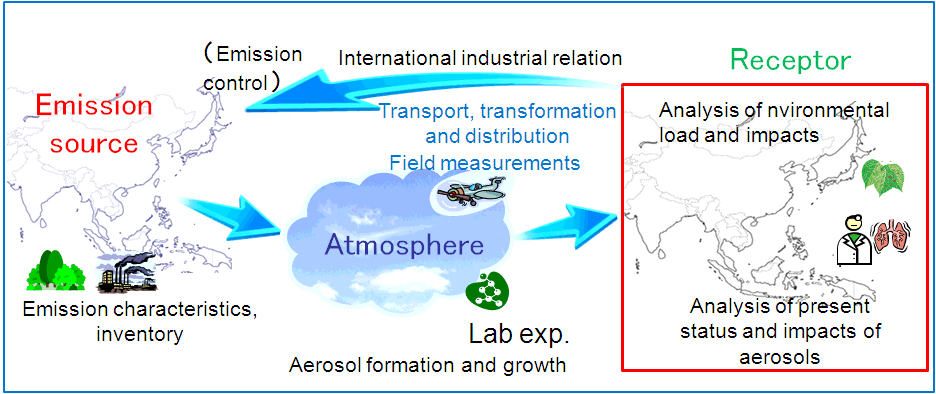Objectives of
This Research Area
Rapid
economical growth in East Asia causes consumption of vast amount of fossil fuel
for energy source, which is quite different from a harmonized development with
the environment. Emission of green house gases such as CO2, acidic
gases such as NOx and SO2, as well as particulate matter affects the environment of the source country,
surrounding countries, and more over, whole northern hemisphere. Not only
regional but global scale atmospheric environmental problems have arisen.
Among these atmospheric pollutants, aerosols attract special attention
these days, because there are many unclear points; for example, aerosol
spatial distribution, formation mechanisms in the atmosphere, quantitative
evaluation of environmental impacts, and so on. Human health, in particular,
has the highest priority to be protected, so that the assessment of the
impacts on human health is urgently needed. In addition, the impacts on
vegetation, which is an important CO2 sink, are also a
very urgent issue to be investigated from a point of view of global warming,
too.
Among
aerosol particles secondary particles produced by gas to particle conversion
exist in fine particle regime called PM2.5 and such fine particles
affect human health significantly. Although primary aerosols are still serious
environmental problems in Asia, secondary aerosols and photochemical ozone
became more and more important issue. Impact assessment and proposal of
mitigation measures connected with measures for global warming are urgently
needed.
This
research area is aiming at elucidating the environmental impacts of aerosols of
East Asian origin and creating a new area of scientific research beyond the
conventional aerosol-related framework, which is essential for decision making on
solving urgent environmental problems. For this purpose, this research area
consists of four research items. Namely, A01: Evaluation of Aerosol Formation and the Emission Sources, A02: Elucidation of Transport and Distribution of Aerosols and Air Pollutants
in East Asia, A03: Elucidation of the Impacts of Aerosols on Plants, and A04: Elucidation of the Impacts of Aerosols on Human Health. Process
studies to be performed in A01 and A02 and impact studies to be performed in A03
and A04 will be made in closer cooperation.
In A01 and
A02 the processes of emission, transformation, and deposition of aerosols from
East Asia will be accessed and clarified. The results are utilized in A03 and
A04 for investigating the present impacts. Then, their results are feed backed
to A01 for evaluation of the future impact. The goal is to provide scientific
data that become the basis of the environmental standards for setting emission
measures under international cooperation and to lead to proposals concerning
those issues.
So far, the
exacerbation of air pollution by aerosols according to rapid economic growth in
East Asia and impacts of various atmospheric pollutants on plants and/or human
health have been studied independently. Therefore, even though various field
observation data were very interesting and important from a point of view of
earth science, it is hard to say that they were utilized to study the impacts
of aerosols. Meanwhile, a lot of experiments have been done, e.g., to expose plants or animals to
air pollutants and particulate matter, but they were mainly targeted local
pollution and those targeted global or regional pollution were quite limited. By
deepening the research collaboration with researchers in this area, it can
contribute to build up a closer relationship among the researchers in different
fields and to raise the academic level of this area.

